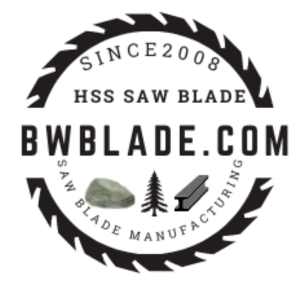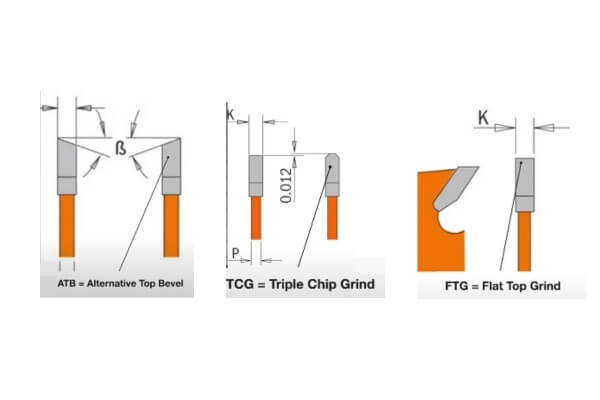
When you first start woodworking, it can seriously be confusing as to what type of blade you need for what cut you will be making. Let me clarify if you're shopping for saw blades in a store or online.
You'll often know little symbols or letters beside the tooth count, some blades written a Z-80, and ATB or FTG. All that does is tell you what type of teeth are on that blade. ATB means that the teeth are beveled alternately (Alternative Top Bevel).It means one tooth will be slanted one way, one to the other sometimes; you'll have a flat tooth mixed in with the alternative teeth FTG (Flat top grind) means that all the teeth are dull, so it's going to cut smooth.

It's going to be a flat cut. You may even know something like triple-chip grinds. All that means is. It has two beveled edges and a flat top so that stuff doesn't matter in your case; pick out your first blade, and keep that stuff from you.
There are many other things on the saw blade that, as a beginner, don't matter, like tooth angle or some of the other acronyms that you're not going to care about just buying your first blade or one of your first blades.
KERF is just how the thickness of the blades.
In other words, how wide of a cut will it make when it passes through the wood? This is a full KERF blade meaning.
They make a thin KERF blade about a 1/8 inch thick; it just means it will take less material on underpowered saws.
In other words, contractor-style saws take less power to push through the material, so sometimes they work better on stuff like the saw I had or even a bench-top style saw, so one of the first considerations.

You have to make on blades what tooth count you want. You can go 24-teeth,50-teeth,80-teeth, or 96-teeth; they're all over the board, so which one do you choose as a beginner? My recommendation for beginners is to start with a combination blade which means it's about 50 or 60-teeth, and it's good for ripping and crosscutting, so imagine if you've got this 2x6 and you're going to cut this when you pull cut something you cut it with the grain so along the length of the board if you're going to crosscut something you're going across the grain or the width of the board.
We suggest 60-teeth. It's a combination blade.so I can crosscut and rip. Cut it works well for sheet goods like plywood and MDF. It also works well on pine it also works well on hardwoods.
It's just an excellent all-around blade. I bought this with my own money. I used this blade on my old table saw. It performed exceptionally well. I've used it on the saw stop, so my lot more powerful. It still performs exceptionally well.
If you change the saw blade on your saw, make sure it's unplugged. In some saws, you must use two wrenches to change the edge carefully, not to drop the nut down; you'll never find it. There's usually a washer and a nut that you have to remove.
You'll slide the blade off, take the new edge, and ensure the teeth face you; if you go this way, it's backward. Some saw blades have a button that you'll push that'll lock the blade from moving, and you'll be able to hold the button and use the wrench to remove the nut; you tighten the edge just snugly. Stay under-tighten or under-tighten, but don't wrench down on them. Just get it good and snug if I was going to rip-cut this piece.in other words, cut it just like we have it lying here through the blade; I had to raise it up as high as possible to get it through that cut.
I would choose a lower tooth count like this 24-teeth because it doesn't have to work as hard to remove that material, but if I want a good clean cross cut or even a rip cut on a smaller piece like this is hard maple.
I will use my 60-teeth blade if I cut it across the grain. If you want an even finer cut, you can go up to 80-teeth or even higher; 62-teeth for most people, is the sweet spot.
Regarding the miter saw, a higher tooth count is best for the table saw because a higher tooth count means it's a better option.
I've used a bunch of different makes and styles of saw blades over the years, and I keep going back to the combination blade that's about a 50 or 60-teeth blade. It works well in most Applications.
Most combination blades will have that alternative top bevel, each blade is beveled at a different angle, so it goes a little to the left or down to the right. In contrast, the flat top or the flat edges, all of these teeth are flat, so that will create a flat cut. There's no angle in any of them.
I'll make a few passes with this alternative tooth, and a flat tooth is a difference, as you know, cutting a groove or a dado with an ATB blade.it's going to leave those little grooves or marks in your wood that joint's not going to be as tight; if you were to put another piece in there basically from this angle, you'd be able to know those little ridges where the blade didn't cut it flat.
Here's where you know the difference between the flat grind and the alternate top angle. This is the ATB, those ridges in there, and then this is flat. It's a perfectly smooth flat cut.
Especially in your home stores, if you cut a lot of dados or half-laps things, I half-lap the excess so they fit together and lock into place. You can use a dado stack to help you clean out that material high-speed because these things stack together and make a wide blade now.
Not all table saws, except the dado stack. You'll have to check with yours to know if the arbor or that bolt in there that the blade goes on is long enough to hold these blades. This is a relatively inexpensive set.
I know I've talked about blades a lot because that's what I use, and I like them a lot; however, really, a BW blade is perfect also; I've used them for years I still have this one.
This is a 96-teeth use it on the miter saw it works exceptionally well, I like BW blades for the value and the link now blade, in my opinion, lasts a lot longer as far as before it needs to be replaced or resharpened in some cases these BW blades. At the same time, they can be resharpened a lot of times.
They're just at that price point where you toss them, but I still think they're perfect quality blades, especially for the price. When I first got my miter saw, I was using the blades.
That comes with it. If you're still doing that, stop it. If things aren't no pleasing, this is serviceable for rough construction. That's what they're meant for. This is a 32-teeth blade, so the lower the tooth count, the harsher the cut, the higher the tooth count, and the finer the cut, so changing the blade on the miter saw is real.
Simple most all of them, it will have some blade lock switch that you push in, that's going to lock the blade, you'll have to raise it don't forget to unplug it, and then you'll remove the guard. Or loosen the bolt, push the guard up, and so you can get to that bolt there to reduce it as far as a miter saw blades go.
I prefer a higher tooth count because a miter saw is a crosscutting machine. That's what you're doing with it unless you're cutting construction-grade lumber a lot for framing and rough construction; then, you can get away with a lower tooth count like a 32-teeth because the cleanliness of the cut doesn't matter.
When you start thinking about cutting sheet goods MDF, plywood-melamine stuff like that, you want a higher tooth count.
In most cases, the 62-teeth combination blade works perfectly fine for all the sheet goods.
I've been cutting here lately. If you want a cleaner cut, 80-teeth or above will be your best bet for most sheet goods.
The arbors or the bolt that holds the blade on are different sizes.
Usually, this is like a 5-8 inch arbor on a table versus a miter saw. This is a one-inch arbor; make sure that you look at your saw; you can measure it or look on the paperwork that you got with your saw to know what size arbor it is and just make sure you're getting the right size arbor or the right size hole in the blade.
You want to avoid getting the blade home, which doesn't fit.
If your blade isn't cutting as well as it used to make a little mess out of your cuts.
Please don't throw it away, or don't even send it to have it resharpened; know that dark stuff there that's the pitch(wood resin build up on a saw blade), significantly when you're cutting softwoods like pine; it builds up pretty quickly picked up this on the store or online(simple green,heavy-duty-cleaner).
So it doesn't get everywhere, spray it on there and let it sit for five minutes. I like these stainless steel brushes. You can also pick those up at the store or online, which helps get that pitch out.
You won't believe how much better a clean saw blade will cut. It's not night and day. It's like putting a new blade on your saw after you clean it. If your saw blade needs to be cleaned therefore spending the money on the new one, pick up some cleaner and clean it regularly. That'll work.







